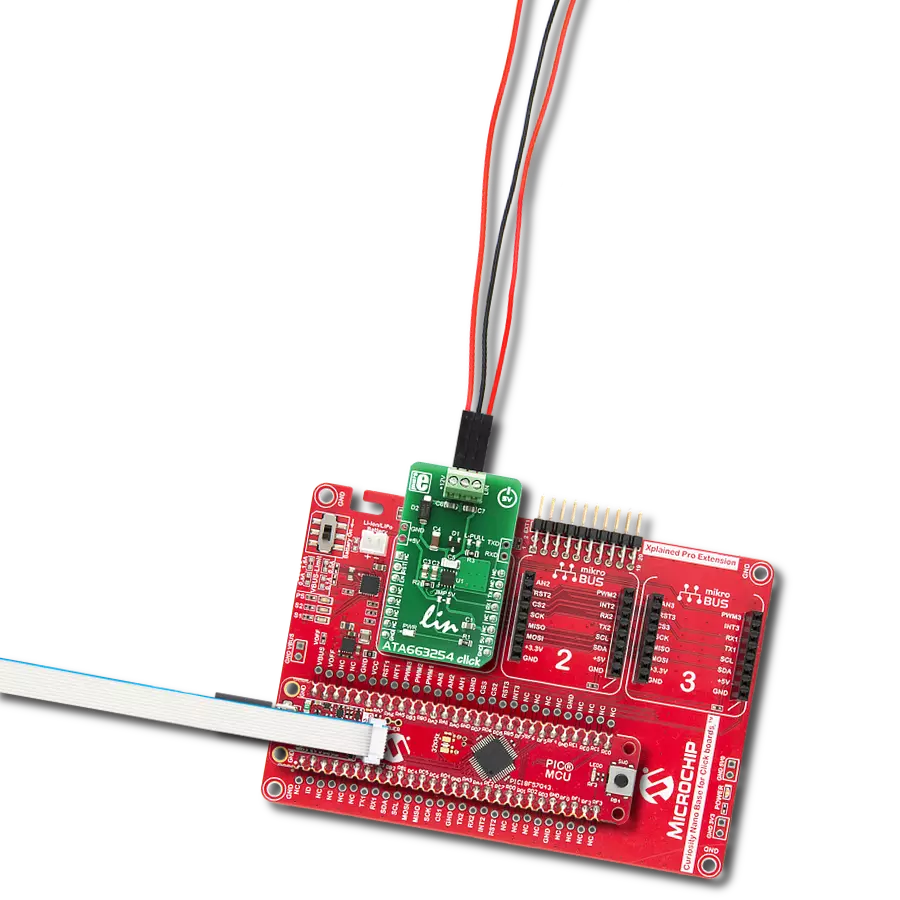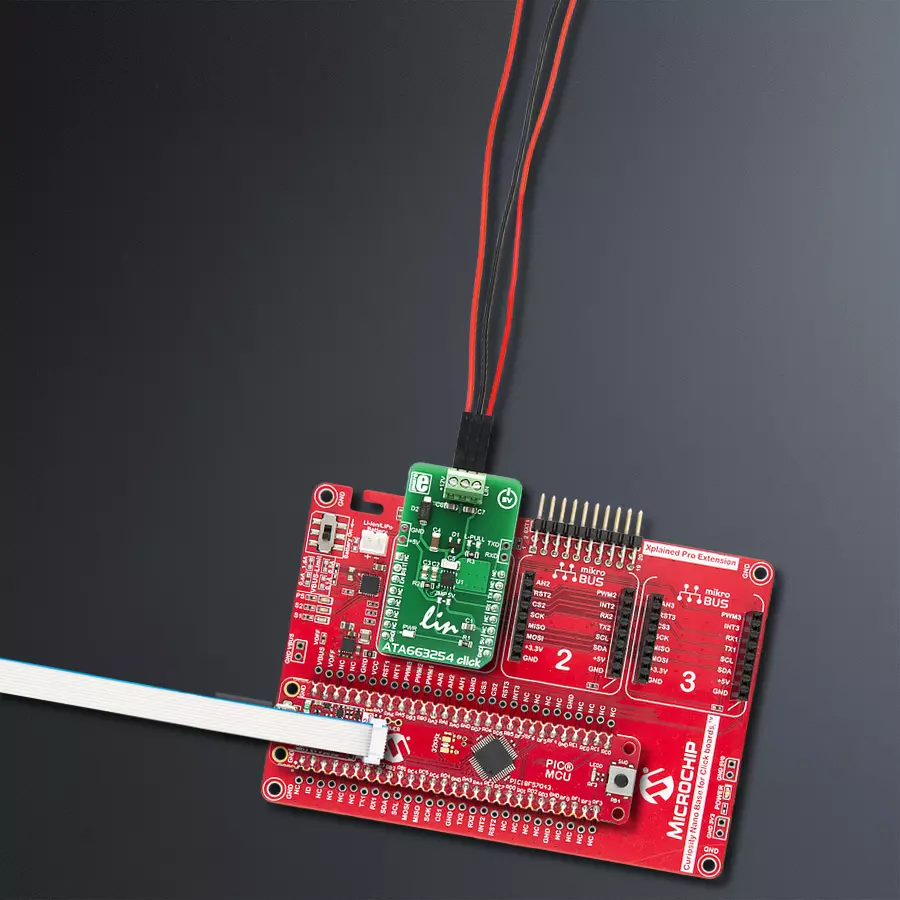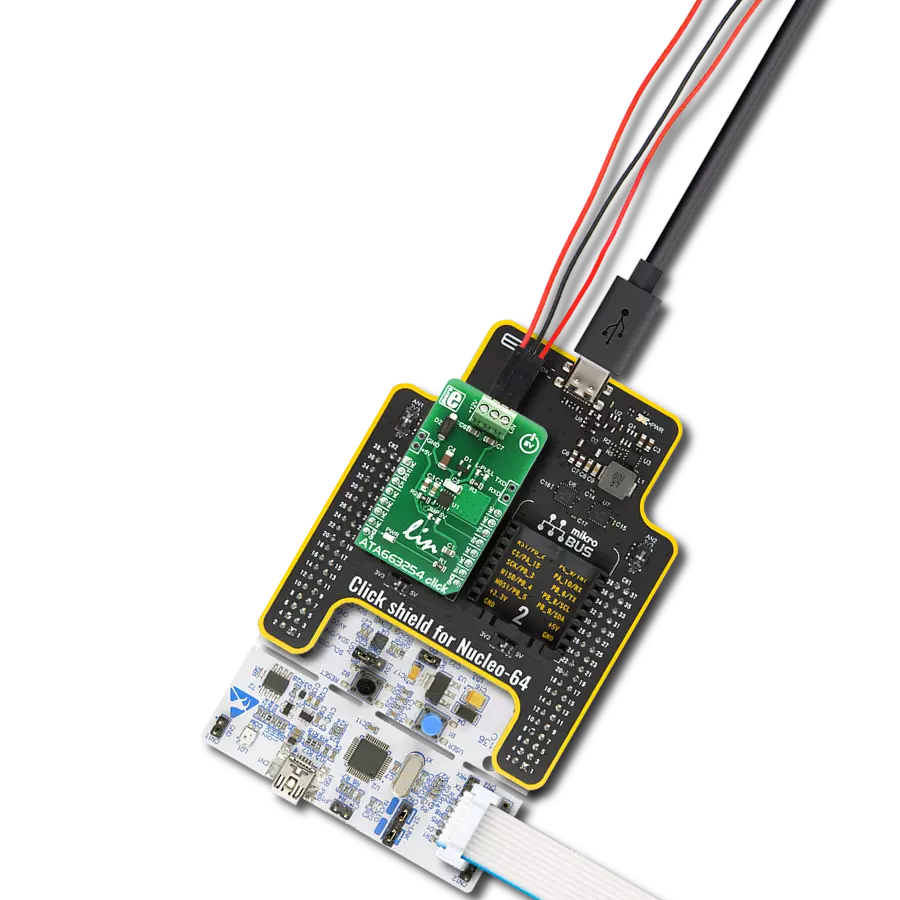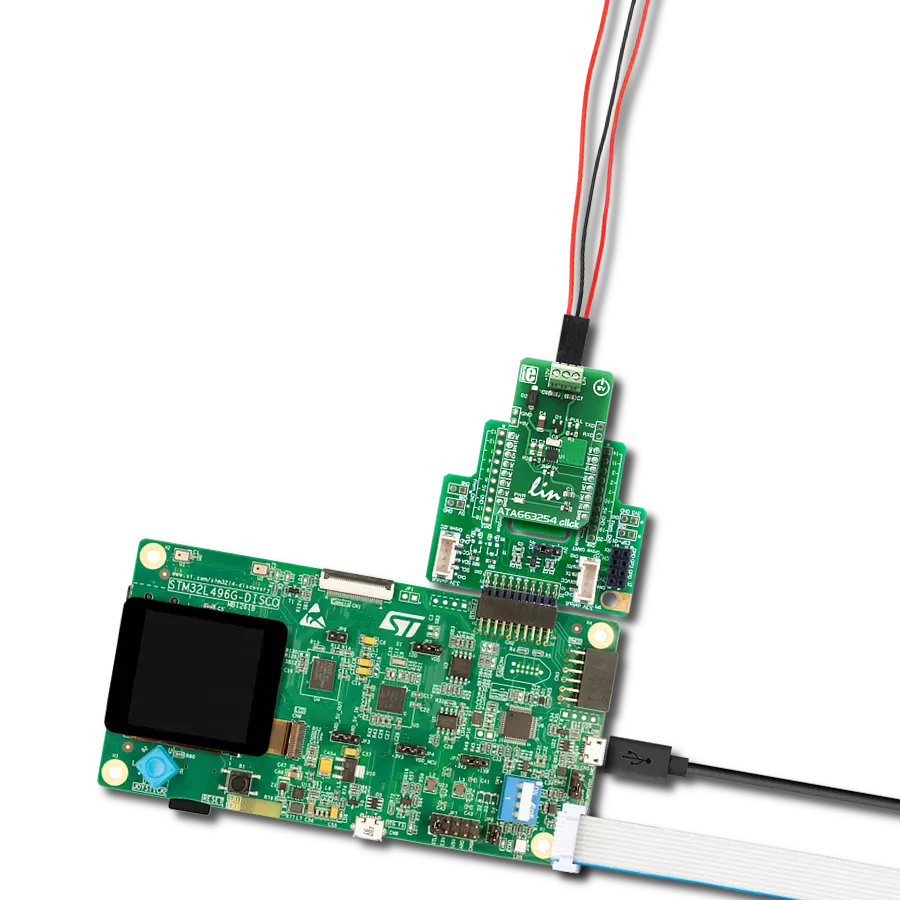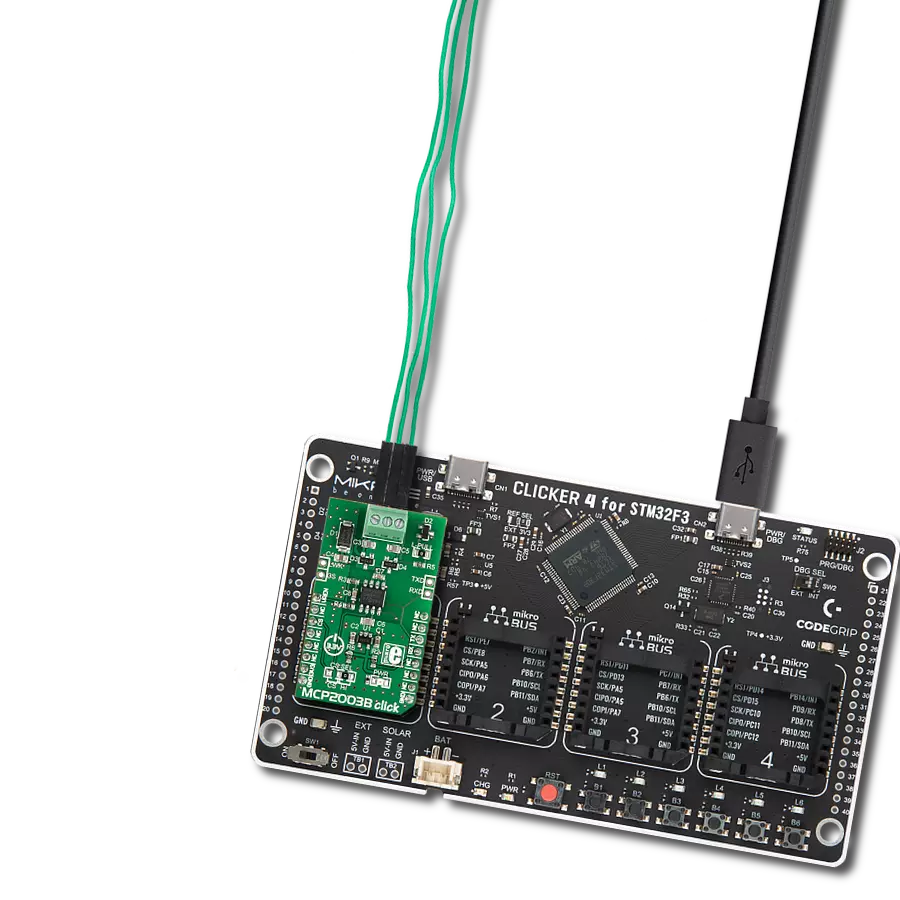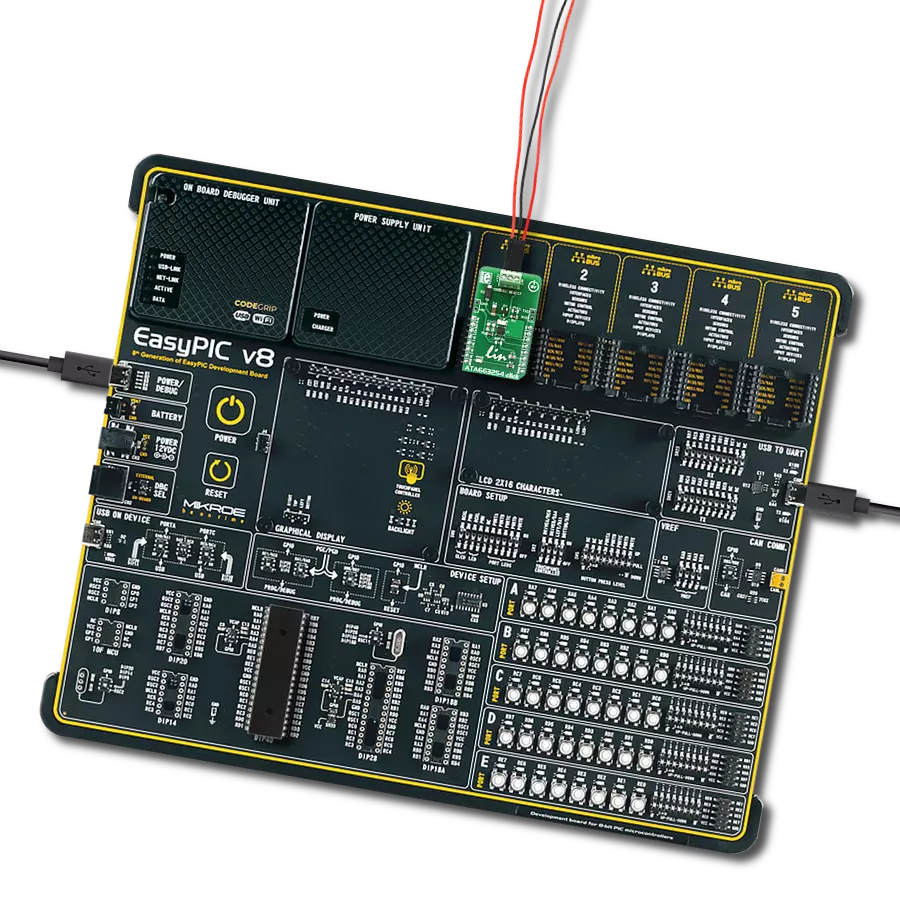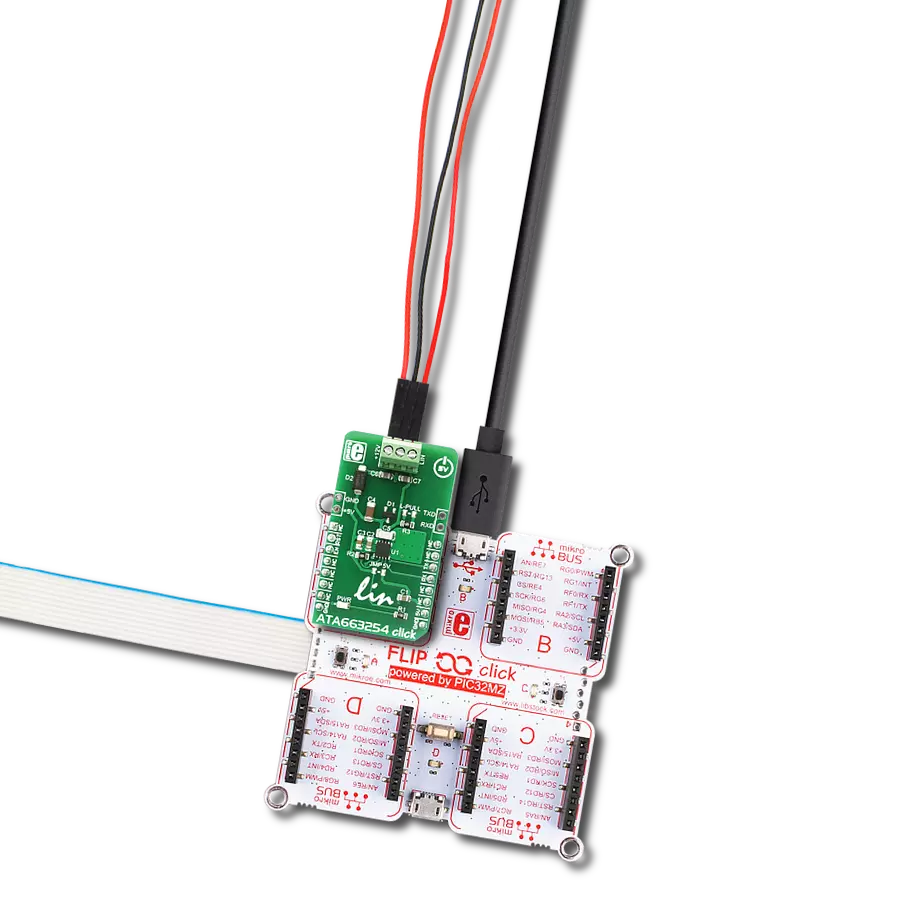Achieve unparalleled reliability in data communication for vehicles and industrial applications, thanks to our cutting-edge LIN transceiver technology
A
A
Hardware Overview
How does it work?
ATA663254 Click is based on the ATA663254, an integrated LIN bus transceiver with the 5V voltage regulator from Microchip. The ATA663254 communicates with the MCU by using the UART RX and TX signals. Besides for communication, these pins also serve to signal the failsafe condition. The failsafe condition can be caused by the undervoltage on the LIN connector: less than 3.9V will cause the undervoltage condition, signaled by the LOW logic state on RX pin and HIGH logic state on the TX pin. A wake-up event from either silent or sleep mode is signaled by the LOW logic state on both of the RX and TX pins. This event is being received via the LIN bus and it is used to switch the ATA663254 click to an active state. RX and TX signals are also routed to the
header on the edge of the click board™ so they can be used independently of the mikroBUS™ socket. The NRES pin of the ATA663254 IC is routed to the RST pin on the mikroBUS™. RST pin is used to signal the undervoltage condition on the LDO regulator section. When the LDO voltage falls under the predefined threshold, the RST pin will be set to a LOW logic state, signaling this condition to the MCU. The LDO output is routed to a header located on the edge of the click so that the LDO can be used independently of the mikroBUS™ socket. Also, there is an SMD jumper that can be shorted if powering up the MCU via the mikroBUS™ 5V pin is required, on a custom board design. Note that the MikroElektronika development systems are not meant to be
powered up by the mikroBUS™ power supply pins, so the ATA663254 click comes without the SMD jumper, by default. The EN pin is used to enable the functionality of the device. When the EN pin is set to a HIGH logic level, the device is set to work in the normal mode, with the transmission paths from TXD to LIN and from LIN to RXD both active. When the EN pin is set to a LOW state, the device is put into silent mode, depending on the TX pin state. The EN pin has a pull-down resistor, so it is pulled to Ground if it is left afloat. Besides the 5V LDO output header and the external UART header, the click is equipped with the three pole connector for an easy and secure connection to the LIN network and the 12V battery power supply.
Features overview
Development board
PIC18F57Q43 Curiosity Nano evaluation kit is a cutting-edge hardware platform designed to evaluate microcontrollers within the PIC18-Q43 family. Central to its design is the inclusion of the powerful PIC18F57Q43 microcontroller (MCU), offering advanced functionalities and robust performance. Key features of this evaluation kit include a yellow user LED and a responsive
mechanical user switch, providing seamless interaction and testing. The provision for a 32.768kHz crystal footprint ensures precision timing capabilities. With an onboard debugger boasting a green power and status LED, programming and debugging become intuitive and efficient. Further enhancing its utility is the Virtual serial port (CDC) and a debug GPIO channel (DGI
GPIO), offering extensive connectivity options. Powered via USB, this kit boasts an adjustable target voltage feature facilitated by the MIC5353 LDO regulator, ensuring stable operation with an output voltage ranging from 1.8V to 5.1V, with a maximum output current of 500mA, subject to ambient temperature and voltage constraints.
Microcontroller Overview
MCU Card / MCU

Architecture
PIC
MCU Memory (KB)
128
Silicon Vendor
Microchip
Pin count
48
RAM (Bytes)
8196
You complete me!
Accessories
Curiosity Nano Base for Click boards is a versatile hardware extension platform created to streamline the integration between Curiosity Nano kits and extension boards, tailored explicitly for the mikroBUS™-standardized Click boards and Xplained Pro extension boards. This innovative base board (shield) offers seamless connectivity and expansion possibilities, simplifying experimentation and development. Key features include USB power compatibility from the Curiosity Nano kit, alongside an alternative external power input option for enhanced flexibility. The onboard Li-Ion/LiPo charger and management circuit ensure smooth operation for battery-powered applications, simplifying usage and management. Moreover, the base incorporates a fixed 3.3V PSU dedicated to target and mikroBUS™ power rails, alongside a fixed 5.0V boost converter catering to 5V power rails of mikroBUS™ sockets, providing stable power delivery for various connected devices.
Used MCU Pins
mikroBUS™ mapper
Take a closer look
Click board™ Schematic

Step by step
Project assembly
Software Support
Library Description
This library contains API for ATA663254 Click driver.
Key functions:
ata663254_get_rst_state- Undervoltage detect functionata663254_generic_write- Generic multi write functionata663254_generic_read- Generic multi read function.
Open Source
Code example
The complete application code and a ready-to-use project are available through the NECTO Studio Package Manager for direct installation in the NECTO Studio. The application code can also be found on the MIKROE GitHub account.
/*!
* \file
* \brief Ata663254 Click example
*
* # Description
* This application demonstates the use of ATA663254 Click board.
*
* The demo application is composed of two sections :
*
* ## Application Init
* Initializes the Click driver and enables the Click board.
*
* ## Application Task
* Depending on the selected mode, it reads all the received data or sends the desired message
* each 2 seconds.
*
* \author MikroE Team
*
*/
// ------------------------------------------------------------------- INCLUDES
#include "board.h"
#include "log.h"
#include "ata663254.h"
// ------------------------------------------------------------------ VARIABLES
#define DEMO_APP_RECEIVER
// #define DEMO_APP_TRANSMITTER
static ata663254_t ata663254;
static log_t logger;
static char demo_message[ 9 ] = { 'M', 'i', 'k', 'r', 'o', 'E', 13, 10, 0 };
static char rec_buf[ 50 ] = { 0 };
// ------------------------------------------------------ APPLICATION FUNCTIONS
void application_init ( void )
{
log_cfg_t log_cfg;
ata663254_cfg_t cfg;
/**
* Logger initialization.
* Default baud rate: 115200
* Default log level: LOG_LEVEL_DEBUG
* @note If USB_UART_RX and USB_UART_TX
* are defined as HAL_PIN_NC, you will
* need to define them manually for log to work.
* See @b LOG_MAP_USB_UART macro definition for detailed explanation.
*/
LOG_MAP_USB_UART( log_cfg );
log_init( &logger, &log_cfg );
log_info( &logger, "---- Application Init ----" );
// Click initialization.
ata663254_cfg_setup( &cfg );
ATA663254_MAP_MIKROBUS( cfg, MIKROBUS_1 );
ata663254_init( &ata663254, &cfg );
ata663254_enable( &ata663254, 1 );
Delay_ms ( 1000 );
}
void application_task ( void )
{
#ifdef DEMO_APP_RECEIVER
// RECEIVER - UART polling
int32_t len = ata663254_generic_read( &ata663254, rec_buf, 50 );
if ( len > 0 )
{
log_printf( &logger, "Received data: " );
for ( int32_t cnt = 0; cnt < len; cnt++ )
{
log_printf( &logger, "%c", rec_buf[ cnt ] );
}
memset( rec_buf, 0 , 50 );
}
Delay_ms ( 100 );
#endif
#ifdef DEMO_APP_TRANSMITTER
// TRANSMITER - TX each 2 sec
ata663254_generic_write( &ata663254, demo_message, 9 );
log_info( &logger, "--- Data sent ---" );
Delay_ms ( 1000 );
Delay_ms ( 1000 );
#endif
}
int main ( void )
{
/* Do not remove this line or clock might not be set correctly. */
#ifdef PREINIT_SUPPORTED
preinit();
#endif
application_init( );
for ( ; ; )
{
application_task( );
}
return 0;
}
// ------------------------------------------------------------------------ END
Additional Support
Resources
Category:LIN
